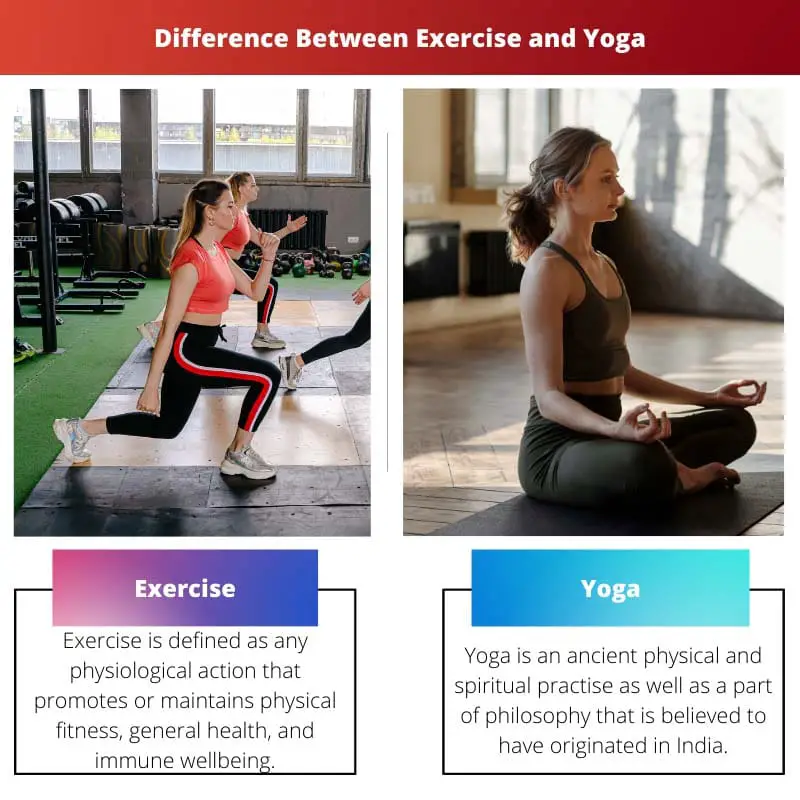Yoga and exercise are common methods of keeping ourselves in shape in modern and Western society, but the two have a lot of distinctions in terms of the end aim and the particular advantages they may have on your mental and physical health.
As both workout and yoga entail body motions, numerous people mistakenly believe that yoga is a kind of fitness workout or exercise and vice versa.
However, there are significant differences between the two, and this article examines both practices, as well as their features and benefits, so you can decide which is best for you.
Key Takeaways
- Exercise primarily focuses on physical fitness and building strength, while yoga encompasses mental, emotional, and spiritual aspects alongside physical well-being.
- Yoga incorporates meditation, breathing techniques, ethical principles, and postures, whereas exercise does not.
- Yoga can improve flexibility, balance, and stress management more effectively than many traditional forms of exercise.
Exercise vs Yoga
Exercise is any physical fitness activity that energizes the muscles and important internal organs, increases blood flow and helps with weight loss. It is also called a workout. Yoga is a group of physical, spiritual and mental disciplines that originated in India and focuses on harmonizing a person’s well-being.

Any physical fitness or strain that energizes muscular activity and some important internal organs is referred to as an exercise or a workout. Most activities increase blood flow, which is good for one’s physical well-being.
Furthermore, by keeping extra pounds off the body, various forms of exercise might help avoid illnesses, disorders or fatigue as well.
Whether people participate in low-intensity sports like walking or high-intensity activities like hill biking, physical workout, or weight lifting, physical activity, aka ‘exercises’, has a wide range of health and mental advantages.
Yoga, on the other hand, is not just concerned with a person’s physical well-being.
It is more like a psychological-philosophy-based, ancient Hindu tradition that focuses on harmonizing a person’s bodily, spiritual, and mental well-being. Yoga is, in reality, a rough translation of the word “union.”
A complete and nutritious human health, according to proponents, is a precondition for attaining a higher state of awareness.
Comparison Table
| Parameters of Comparison | Exercise | Yoga |
|---|---|---|
| Definition | Exercise is defined as any physiological action that promotes or maintains physical fitness, general health, and immune wellbeing. | Yoga is an ancient physical and spiritual practise as well as a part of philosophy that is believed to have originated in India. |
| Aspects | Aims for weight loss, strengthening muscles and staying physically fit. | Aims for harmonizing a person’s bodily, spiritual, and mental well-being |
| Advantages | Helps in growth and physical toughness. | Helps in development and general well being both physically and mentally. |
| Calorie Consumption | Most exercises cause loss of high to moderate calories. | Yoga doesn’t cause loss of calories. Some asanas may involve the loss of low to moderate calorie loss. |
| Nervous System Involved | Involves sympathetic nervous system. | Involves parasympathetic nervous system. |
What is Exercise?
Any physiological action that improves or sustains physical fitness and general health along with immunity wellness is considered an exercise. Exercise exerts a lot of strain and positive pressure on our organs and muscles to improve their threshold and health.
It is done for a variety of purposes, including to help with development and endurance, to prevent aging, to strengthen muscles and the bloodstream, to perfect sports abilities, to lose or maintain weight, to enhance health, or simply for fun.
Many people prefer to exercise outside since it allows them to interact, congregate in groups, and enhance their overall health. Exercise is known for its intense body-waking factors that act as a strong stimulus to mold the body into a fit and stern shape.
Exercises and workouts focus mostly on the physique-building and maintaining factors, unlike yoga, which focuses on people’s body, intellectual, and spiritual development.
Exercise mainly focuses on the physical connection of the human body along with charging up the soul and livening up the blood flow to our organs.
Many internal biological organs and processes, such as the gastrointestinal tract, respiratory system, vascular system, and others, are enhanced and improved by frequent exercise, according to specialists.
It aids in the prevention and treatment of a variety of illnesses and ailments, including cholesterol imbalance, overweight, and gastritis.

What is Yoga?
Yoga is a great practice that is still observed all around the world. It all began thousands of years ago in India. It is the outcome of Maharishi Patanjali’s Yoga Sutra, a treatise authored by a few of the greatest hermits of his time, Yogi Patanjali.
Patanjali gathered all of his learning on the practice of uniting one’s brain, heart, and spirit into the yoga sutra, which equates to the “science of unification” in Sanskrit.
When you complete an asana in yoga, your body relaxes, and your blood consumption decreases. The heart is relieved of tension, and the body is relaxed, reducing the burden on the respiratory system.
It has a calming and cathartic effect on the user. Yoga is self-sufficient; it may be practised anywhere, at any time, with just a little amount of space required; a yoga mat is not even required.
When considering yoga, one must know the applications and features of ‘Hatha’ yoga as well. Hatha yoga’s ultimate goal is to achieve Nirvana, a greater stage of achieving knowledge and awareness.
To cleanse the brain, the physical state of a human, one must go through an absolute filtration process to eliminate impurities and allow the ‘nadis’ to operate and energy blockages to be freed.
Hatha yoga’s fundamental goal is to achieve an ultimate equilibrium of the physiological body’s, brain’s, and power’s interacting actions and functions.

Main Differences Between Exercise and Yoga
- Exercise speeds up breathing, making the lungs work a lot harder, but yoga puts the physique in a calm condition, reducing the burden on the respiratory system.
- Exercise is for physical fitness, whereas yoga aims at overall physical, mental, and emotional well-being.
- Exercises require external equipment, whereas yoga needs no equipment and can be practised by anyone regardless of age.
- The body sees exercise as a stimulus to strain; it can raise levels of cortisol, but yoga puts the body under no pressure and instead aids in relaxing the mental, physical, and emotional states.
- Exercises aim for better muscle and bone strengthening, whereas yoga focuses on techniques of breathing and circulation of blood flow in the body.




